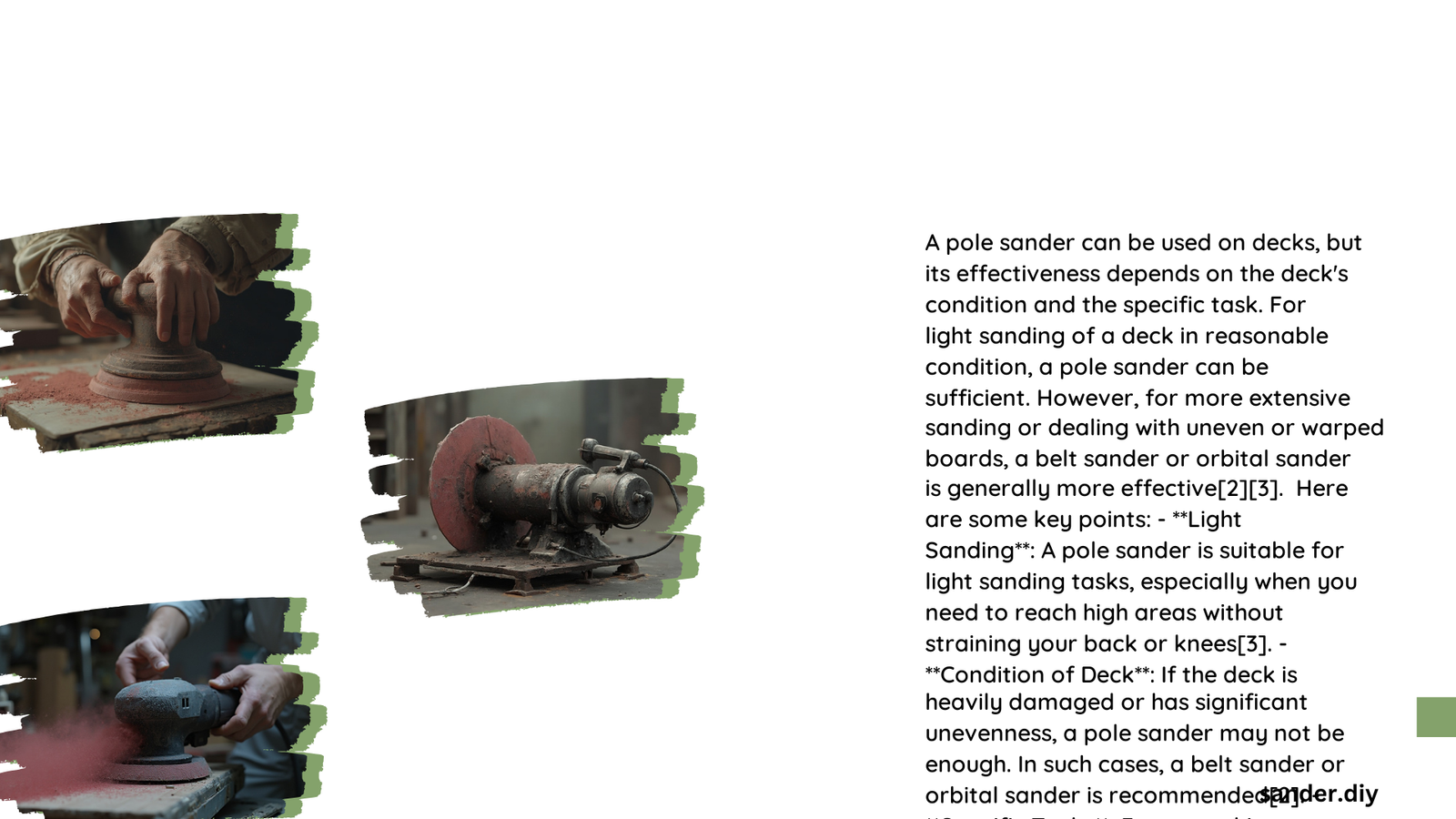A pole sander can be an effective tool for deck refinishing, offering extended reach and accessibility. While not the primary choice for large-scale deck sanding, it can be useful for specific areas and tasks. This article explores the effectiveness of pole sanders on decks, discussing optimal sandpaper types, benefits, challenges, and cost considerations to help you determine if a pole sander is suitable for your deck project.
What Are the Optimal Grit Sandpaper Types for Deck Sanding?
When using a pole sander or any other sanding tool on a deck, it’s crucial to use the right grit progression:
- Coarse grit (36-40 grit): For stripping old finishes and smoothing rough surfaces
- Medium grit (60-80 grit): For further smoothing after initial coarse sanding
- Fine grit (120-220 grit): For final smoothing and preparation for staining or sealing
This progression ensures effective removal of old finishes and proper preparation of the wood surface for new treatments.
How Much Coverage Can a Pole Sander Provide?

While specific coverage rates for pole sanders are not widely documented, we can draw comparisons to other sanding tools:
- Belt sanders and orbital sanders typically cover 100-200 square feet per hour for coarse sanding
- Coverage rates decrease for finer grits
- Pole sanders may have lower coverage rates due to their design and manual operation
Factors affecting coverage include:
– Tool power
– User efficiency
– Wood condition
– Grit of sandpaper used
What Are the Benefits of Using a Pole Sander on Decks?
Reaching Tight Spaces and Elevated Areas
Pole sanders offer several advantages for deck sanding:
- Extended reach for hard-to-access areas
- Reduced need for ladders or scaffolding
- Improved safety when working on elevated sections
- Greater accessibility for tight spaces between railings or near walls
Efficiency and Finish Quality
While not as powerful as dedicated deck sanders, pole sanders can still be efficient:
- Cover larger areas without frequent repositioning
- Achieve a good finish with proper technique and grit progression
- Ideal for spot treatments and touch-ups
What Challenges Might Be Encountered When Using a Pole Sander on Decks?
Multiple Passes and Moisture Impact
Using a pole sander on decks can present some challenges:
- Multiple passes required, especially on weathered wood
- Frequent sandpaper changes may be necessary
- Moisture can negatively impact sanding effectiveness
- Wet wood should be avoided to prevent damage and poor results
Technique for Even Finish
Achieving an even finish with a pole sander requires proper technique:
- Keep the sander flat against the surface
- Use consistent, steady back-and-forth motions
- Apply even pressure to avoid creating divots or uneven areas
- Pay extra attention to edges and corners
What Are the Cost Considerations for Using a Pole Sander on Decks?
Rental or Purchase Prices
Pole sanders are generally more affordable than specialized deck sanders:
| Option | Price Range |
|---|---|
| Rental | $20 – $50 per day (if available) |
| Purchase | $50 – $200 |
Sandpaper Costs
Sandpaper costs can add up, especially when using multiple grits:
- Coarse Grit (36-40): $5 – $10 per pack
- Medium Grit (60-80): $5 – $10 per pack
- Fine Grit (120-220): $10 – $20 per pack
Labor Costs
If hiring professionals, labor costs for deck sanding and refinishing can vary:
- Average cost: $2 – $5 per square foot
- For a standard 200-400 square foot deck: $400 – $1,000
Timeline for Completing a Standard-Sized Deck
The timeline for a deck refinishing project using a pole sander may be longer than with more powerful tools:
- Preparation and cleaning: 1-2 days
- Sanding: 2-4 days (depending on deck condition and number of passes)
- Staining or sealing: 1-2 days
- Total estimated time: 4-8 days
Conclusion: Is a Pole Sander Effective for Deck Refinishing?
While a pole sander can work on decks, it may not be the most efficient option for large-scale refinishing projects. However, it can be effective for:
- Spot treatments
- Hard-to-reach areas
- Smaller decks or touch-ups
For comprehensive deck refinishing, consider combining a pole sander with more powerful tools like belt or orbital sanders for optimal results.
References:
1. https://deckrestorationco.com.au/how-long-does-it-take-to-sand-a-deck/
2. https://www.tcrmn.com/blog-feed/2021/3/9/power-washing-vs-power-sanding-your-deck
3. https://mrsander.co.uk/wood-floor-sanding/sanding-vs-power-washing-which-is-best-for-your-deck/
